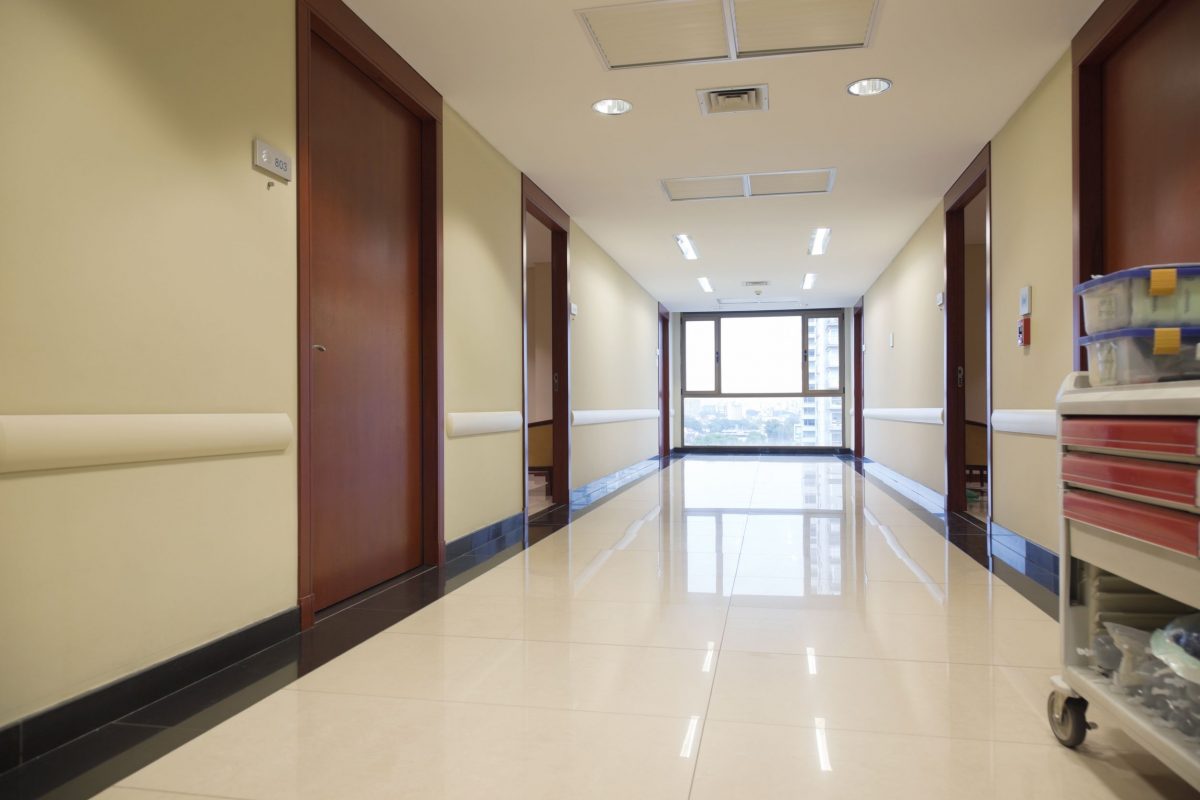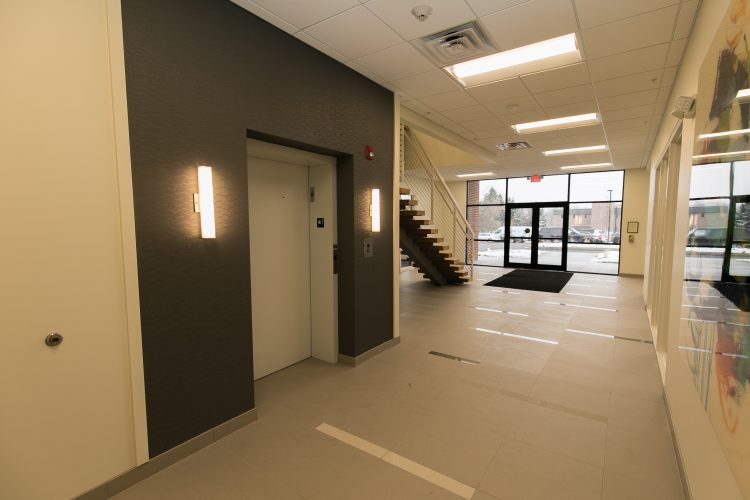Flooring Options for Healthcare Facilities

When constructing a healthcare facility that promotes healing and accessibility, the flooring is a critical part of the design. Healthcare facilities and hospitals experience a high flow of unique traffic. That means they require specialized flooring for each area in the facility to make it as comfortable and clean as possible. Below are some common room layouts for a hospital and flooring options to consider for each one.
How Flooring Supports the Healthcare Built Environment
Flooring is one of the most essential parts of keeping your healthcare facility clean and safe, supporting not just your staff but also all patients and visitors. The flooring you select for the hospital can reduce ambient noise, as well as reduce staff fatigue, protecting the knees with softer materials.
Furthermore, depending on the sanitization needs of the healthcare facility, different types of flooring such as LVT and sheet vinyl can be installed to reduce the chance of infection. Because of these flooring types’ lack of scratching, ease of maintenance, and overall durability, potential cross-contamination of infectious germs picked up on the feet is reduced.
Entrances, Exits, and Corridors
The first area patients and visitors see in a hospital are the entrances. These floors will experience the heaviest foot traffic. Hospital entrances should feature a welcoming, durable floor that will make a strong first impression. Terrazzo and luxury vinyl tile (LVT) are good options for hospital entrances because these materials are durable and stand up well to heavy traffic. Sheet vinyl flooring also features design versatility to give you options with aesthetics (also a good choice for the hallways).
Operating Rooms & Emergency Rooms
In the areas with the most stringent infection control requirements, you want materials that are easy-to-clean and promote cleanliness. Furthermore, these areas are often in use 24/7, so you need flooring that can be maintained quickly and easily, rather than closing down the rooms for an extended amount of time for waxing with large machines. A smooth flooring that is installed properly will stop dirt and fluids from hiding in crevices or beneath surfaces. We recommend LVT, linoleum, or sheet, because the materials and installation process make it possible to create aseptic spaces.
Hospital Cafeterias
Cafeteria floors will also receive a great deal of traffic (and messiness from food/beverage spillage). Additionally, these are areas where patients and visitors alike may come to visit each other, so it’s important that the flooring remains clean of germs. You may want to choose a textured pattern for the cafeteria floor, which is slip-retardant and will hide scuffs and scratches. While the flooring for healthcare facilities, patient rooms and hallways should be light-colored to improve the appearance of cleanliness, the hospital cafeteria can use patterning to its advantage. Sheet vinyl, LVT, and tile are all flooring types that meet the requirements of a hospital cafeteria. The natural textures and design versatility of these materials allow general contractors to create a comfortable cafeteria environment that promotes relaxation.
Treatment Areas and Nurse Stations
A nurse station can’t simply shut down for floor polishing and waxing. In these areas, you want a flooring material that is comfortable and will minimize maintenance time. LVT and bio-based tile (BBT) are good choices for these areas. These materials have protective coatings which minimize the need for chemical cleaning and buffing. LVT materials have adhesive backings, which reduce installation time and disruption to patient care.
Patient Rooms
These rooms don’t require aseptic flooring, which means you have more options to make patient rooms more homelike and comfortable. LVT, linoleum, and sheet tile are good materials because you can promote the natural look of stone, wood, or tweed while maintaining durability and staying within your budget. We also have many textile flooring options, which provide the look and feel of carpet while keeping the performance benefits of tile flooring.
6 Types of Commercial Healthcare and Hospital Flooring Options
There are many different types of commercial healthcare and hospital flooring options. Depending on the type of healthcare facility, different flooring types may be suitable for use. Most healthcare facilities utilize a mixture of flooring options depending on the room and intended use. Overall, however, luxury vinyl tile (LVT) and sheet vinyl are among the top choices for any facility.
1. Luxury Vinyl Tile (LVT)
Luxury vinyl tile is composed of printed material beneath multiple layers of vinyl tiling, allowing it to closely mimic the texture and appearance of stone, tile, wood, stone, and concrete.
This type of tile is not ideal for operating rooms or patient rooms, as there are seams that can allow microbes to settle in, making infectivity controls and cleaning difficult. It is, however, a popular choice for use in corridors, office spaces, and entryways. With a proactive cleaning regimen, some hospitals also utilize it in patient rooms to provide a more homely feeling to patients.
2. Vinyl Composite Tile (VCT)
This type of flooring is less expensive to install than most types of flooring, but it takes a lot of time and effort to maintain and clean as it expands and contracts, leaving gaps where microbes can settle int othe flooring. This type of flooring may be suitable for entryways or lobbies where there is not a lot of activity.
Vinyl Composite Tile is a classic flooring type, though it is not as popular as LVT. The reason behind this is because of its expense to maintain; this type of flooring requires frequent stripping, waxing, and polishing to maintain an attractive appearance. These activities can be disruptive in the typical healthcare facility setting, leading many hospitals with VCT to swap it out with LVT and sheet vinyl.
3. Sheet vinyl
Ideal for operating rooms and ICU corridors, this type of flooring is a popular choice for infection control procedures, and it is very easy to clean. Sheet vinyl flooring can also be coved up a wall to prevent cracks and crevices from forming and collecting germs, allowing the entire surface to be cleaned and disinfected quickly and easily.
Sheet vinyl flooring is at an advantage because it can cover a large expanse of space, and the seams are heat-sealed into place to prevent microorganisms and germs from settling into the cracks. Furthermore, this type of flooring is easy to walk on, ensuring that patients of limited mobility can roam freely without trouble.
4. Rubber Flooring
Rubber flooring is a particularly sought-after type of flooring for stairwells, entryways, and nurse stations. This type of flooring provides a soft cushion underfoot, reducing staff fatigue while providing sound absorption.
It’s a great type of flooring to furnish for staff areas that receive a lot of foot traffic or require a lot of standing and will improve overall employee satisfaction. This type of flooring is unfortunately cost prohibitive for furnishing hallways and patient rooms and requires specialized cleaning. The obstacles to maintaining this type of flooring make it so that it is not ideal for patient areas or ICU units. Because of the slightly tacky texture of rubber, it’s important to note that rubber flooring over a larger expanse can be a hazard to patients of limited mobility, though it will cushion accidental falls better than other types of flooring.
5. Bamboo Flooring
This type of flooring is comfortable and provides a much more natural feel to the space than carpeting or rubber flooring. This type of flooring is not ideal for high-traffic areas like main lobbies or thoroughfares inside the hospital, but it is a popular choice for specialty areas such as chapels and private waiting rooms.
This type of flooring is not suitable for operating rooms, patient rooms, or ICU corridors where there is a greater need for infectivity control, as it is not as easy to clean as LVT and other types of seamless flooring. Bamboo flooring is best used in smaller locations where there is less foot traffic, and a greater need for comfort.
6. Commercial Carpeting
Commercial carpeting is an excellent choice for waiting rooms, lobbies, and office spaces. These rooms are places where visitors need to feel comfortable, allowing them to relax and spend time waiting for their appointment while reducing anxiety or impatience. Carpeting provides a softer feeling from the rest of the hospital while retaining the ease of maintenance and a clean and professional appearance.
Carpeting is not suitable for all areas of the healthcare facility, especially in areas where patients may be sick or beverages may be spilled. While these areas can be cleaned, it’s much more difficult to clean pathogens and other germs from the flooring than LVT or sheet vinyl, where there are fewer grooves and places for bacteria to gather.
Call Surface Design Solutions when you are ready to discuss your hospital flooring. Reach us at 585-444-0105, or fill out our online contact form.
Related Posts

